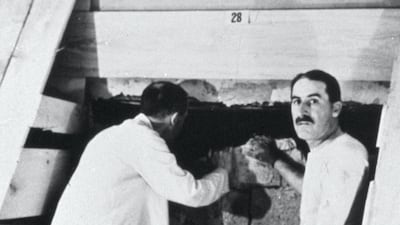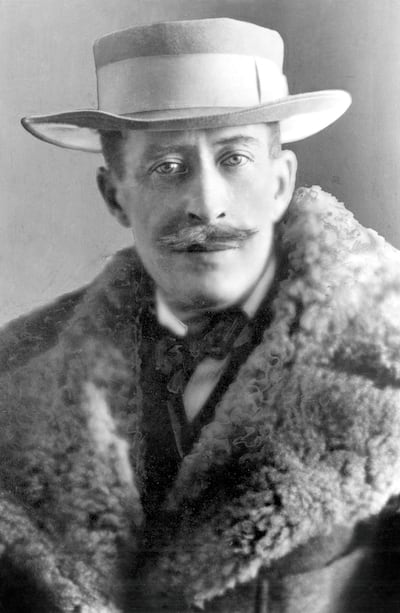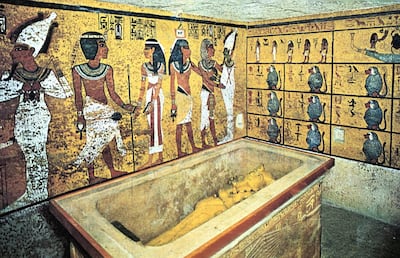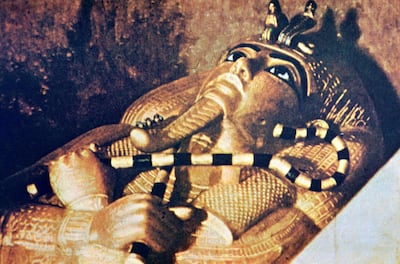They came to say farewell to a man who, as his obituary in The Times reported, was "the great Egyptologist … who gained fame for his part in one of the most successful and exciting episodes in the annals of archaeology." And yet Howard Carter, who died 80 years ago this month, was laid to rest in the presence of only nine mourners. The British archaeologist uncovered the treasure-filled tomb of Egyptian pharaoh Tutankhamun in 1922, but had since withdrawn from public life, untouched by any official honours in his homeland. He died as he had lived: as an outsider.
His simple service in south London was a far cry from the splendour of the funeral of the Egyptian boy king whose tomb Carter discovered. The unearthing of Tutankhamun, who died around 1323BC and was buried in Thebes (modern-day Luxor), brought Carter to the attention of the world. But his fame also became a psychological burden that consumed him for the rest of his days.
"In many ways, the discovery of Tutankhamun's tomb was Carter's own 'curse', as he was unable to move on," says Joyce Tyldesley, a reader in Egyptology at the University of Manchester, referring to the supposed "curse" of Tutankhamun, which some people blamed for the handful of deaths suffered by some of Carter's team and other eminent visitors to the tomb shortly after its discovery. "He dedicated the rest of his life to clearing the tomb and conserving the grave goods, and died before he was able to complete a full publication of his work."
Early life
Carter's rise to prominence was extraordinary. He was born in Kensington, London, in 1874, and was the youngest of 11 siblings. He was a sickly child and was sent to live with an aunt in the country, where it was thought the rural air would strengthen him. His formal education was cut short after several years of rudimentary learning, probably as a result of financial considerations, leaving him to face the prospect of an unfulfilled work life. Fortunately for the young Carter, however, his ability as an artist enabled him to secure modest commissions. That talent also took him to Egypt in 1891, with the help of an influential member of the Egypt Exploration Fund, Percy Newberry, who arranged for Carter to work as a tracer for ancient tomb scenes.
Such was Carter's ascendancy in Egypt, where he soon cut his teeth as an archaeologist under the guidance of Sir William Flinders Petrie, that he was appointed chief inspector of antiquities for Upper Egypt in 1899. Carter was a surprising choice for the role given his limited archaeological experience and lack of formal qualifications, but he resigned six years later after French tourists clashed with Egyptian monument guards at the sacred site of Saqqara. "Loyal to his men and forever obstinate, Carter defended their actions and refused to apologise," Archaeology Magazine said of the incident in a story printed in 2005. Carter had accused the tourists of behaving rowdily and sided with the Egyptian workers. Ultimately, the incident prompted the Englishman to step down and spend time in self-imposed exile.
Unearthing the tomb of Tutankhamun
His famous association with Lord George Carnarvon, the wealthy benefactor who sponsored Carter's excavations in Egypt, began in 1907. And while more than a decade of work unearthed little of enormous value, Carter's dedication was rewarded in November 1922 when the tomb of Tutankhamun was revealed in all its shining glory. The moment Carter peered through the doorway to the tomb and saw its contents has become archaeological folklore. Lord Carnarvon asked him: "Can you see anything?" Carter, who was holding a flickering candle to illuminate the tomb, is said to have replied: "Yes, wonderful things." Carter wrote in his journal that his exact words were:
"Yes, it is wonderful," but that is often overlooked.
More than 5,000 items were found inside the tomb, including a gold coffin, a royal chariot and the pharaoh's death mask. Together, Carter and Carnarvon unearthed the best-kept and most complete pharaoh's tomb in the Valley of Kings. Its discovery provided an incomparable insight into the contents of a royal Egyptian tomb. Professor John Darnell, director of the Yale Egyptological Institute in Egypt, says Carter's documentation of the artefacts is extraordinary.
"The way he documented each element, the way he drew the pieces and tried to work out the method of construction and manufacture, I can't imagine anyone doing it more conscientiously," Darnell says.
Why he's still a hero today
Yet Carter, who was nearly 50 when he made his pioneering discovery, was something of a misfit. Darnell says Carter was conscious that he did not possess the schooling of many of his colleagues. "He actually lacked a great deal of what we now – or even people then – would call a formal education," he says. "In terms of going into academia, he did not have the background that others had. He would have been conscious of this."
Indeed, in an obituary of Carter, Guy Brunton, a fellow English archaeologist, remarked: “Naturally generous and good-natured, he was so afraid of being taken advantage of that he deliberately stifled many of his good qualities.”
Despite his relative obscurity today, Carter remains a hero to Daniel Meyerson, author of In the Valley of the Kings: Howard Carter and the Mystery of King Tutankhamun's Tomb, who says that Carter's brusque demeanour suggested that he felt a constant need to prove himself. "He wasn't a particularly likeable character," says Meyerson. "He went into 'black dog' rages and he was an angry man, a very solitary man."
Tyldesley says that Carter's achievement was too easily consigned to the realms of "popular archaeology", but its significance is today being reassessed as the 100th anniversary of the discovery of Tutankhamun's tomb draws closer. Tyldesley, who wrote Tutankhamun's Curse: The Developing History of an Egyptian King, explains that the pharaoh "has traditionally been a very difficult subject for academic Egyptologists, who have often resented the fact that this one king, who ruled for maybe 10 relatively insignificant years out of 3,000-plus years of dynastic rule, attracts so much attention". However, Tyldesley says that Carter's work is "being recognised as the good job it undoubtedly was".
How should he be remembered?
As the spark that launched Egyptology on to the global stage, Carter's discovery brought him great fame and he even received fan mail. Indeed, as the discovery occurred just a few years after the end of the First World War, his breakthrough also tapped into something more profound. In 1923, the New York Times reported: "As the objects have been brought out, spectators have remarked that, from the manner in which they were bandaged and transported with almost tender care on the stretcher-like trays, they reminded one of casualties being brought out of the trenches or casualty clearing stations."
Put simply, Tutankhamun made Carter a global sensation, but he was not considered worthy of being honoured by the great and the good of Britain.He may be celebrated in the annals of archaeology, but Carter received no formal acknowledgement of his accomplishment in his own country. (Yale University awarded Carter an honorary doctor of science degree in 1924.) When Lord Carnarvon died in 1923 from an infected mosquito bite, which some people have attributed to the "curse", he took with him any chance Carter had of furthering his influence.
But how should Carter be remembered? Darnell says the pioneer should be remembered as a man who never gave up on his ambition to discover the tomb. "He had determination and doggedness," Darnell says. "He suffers a number of vicissitudes and setbacks … but kept going … it was nice that both he and Carnarvon were rewarded by finding the tomb of Tutankhamun."
Carter struggled to gain acceptance from his peers, but one ancient mummy has ensured that his legacy will live on forever.
Who was King Tutankhamun?
Katy Gillett gives us the run down on the young Egyptian pharaoh
The so-called boy king was an ancient Egyptian pharaoh who ruled for 10 years until he died unexpectedly, aged 19, in about 1324BC.
King Tut, as he is colloquially known, is thought to be the grandson of the pharaoh Amenhotep III, and the son of Akhenaten, whose reign was controversial as he introduced singledeity worship, overturning a centuriesold religious system that came before it. Akhenaten also moved Egypt’s capital from Thebes to Amarna.
King Tut’s original name was Tutankhaten, which signified his parents worshipped Aten, the sun god, but after a few years on the throne he began to worship Amun, known as the king of the gods, and changed his name. In between Tut and his father, two pharaohs briefly reigned, before the nine-year-old prince ascended to the throne.
The young leader reversed his dad’s reforms, which won him favour, but he was physically frail, with a clubbed left foot and degenerative bone disease. It’s not entirely clear how he died: his remains revealed a hole in the back of his skull, leading historians to think he was assassinated, but more recent tests suggest this was made during mummification. Later scans have shown he also had an infected broken leg, plus several malaria parasites.
His legacy was practically negated by his successors, and King Tut was barely a glint in the modern world’s eye until Howard Carter’s discovery of his tomb in 1922. By then, the royal tomb, the smallest in the Valley of the Kings, had been sealed and forgotten about for more than 3,200 years. Yet the hoard of treasures found within revealed much about royal life and burial traditions in ancient Egypt.
The artefacts have been exhibited worldwide, but the most fragile among them, including King Tut’s burial mask, must remain in Egypt. His mummy is still on display inside his Luxor tomb in a climate-controlled glass box.





